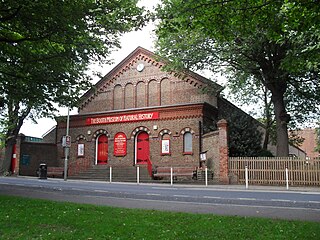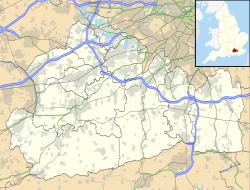
The town of Haslemere and the villages of Shottermill and Grayswood are in south west Surrey, England, around 38 mi (62 km) south west of London. Together with the settlements of Hindhead and Beacon Hill, they comprise the civil parish of Haslemere in the Borough of Waverley. The tripoint between the counties of Surrey, Hampshire and West Sussex is at the west end of Shottermill.

Petworth is a town and civil parish in the Chichester District of West Sussex, England. It is located at the junction of the A272 east–west road from Heathfield to Winchester and the A283 Milford to Shoreham-by-Sea road. Some twelve miles (21 km) to the south west of Petworth along the A285 road lies Chichester and the south-coast. The parish includes the settlements of Byworth and Hampers Green and covers an area of 2,690 hectares. In 2001 the population of the parish was 2,775 persons living in 1,200 households of whom 1,326 were economically active. At the 2011 Census the population was 3,027.

Chichester is a local government district in West Sussex, England. Its council is based in the city of Chichester and the district also covers a large rural area to the north.

Midhurst is a market town, parish and civil parish in West Sussex, England. It lies on the River Rother 20 miles (32 km) inland from the English Channel, and 12 miles (19 km) north of the county town of Chichester.

Sir Jonathan Hutchinson, was an English surgeon, ophthalmologist, dermatologist, venereologist, and pathologist, who notably advocated for circumcision.

Fernhurst is a village and civil parish in the Chichester District of West Sussex, England, on the A286 Milford, Surrey, to Chichester road, 3 miles (4.8 km) south of Haslemere. The parish includes the settlements of Henley Common, Kingsley Green and Bell Vale, lies within the boundaries of the South Downs National Park and is surrounded by hills.

Kenneth Wood was an English engineer, entrepreneur and businessman. He is best known as the founder of the Kenwood Manufacturing Company and for the development of the eponymous Kenwood Chef food mixer.

George O'Brien Wyndham, 3rd Earl of EgremontFRS of Petworth House in Sussex and Orchard Wyndham in Somerset, was a British peer, a major landowner and a great art collector. He was interested in the latest scientific advances. He was an agriculturist and a friend of the agricultural writer Arthur Young, and was an enthusiastic canal builder who invested in many commercial ventures for the improvement of his estates. He played a limited role in politics.

Lodsworth is a small village, ecclesiastical parish and civil parish in the Chichester district of West Sussex, England. It is situated between Midhurst and Petworth, half a mile north of the A272 road. It lies within the South Downs National Park, just to the north of the valley of the River Rother; a tributary stream the River Lod runs close to the east end of the village.

The Sir Harold Hillier Gardens is an arboretum comprising 72 hectares accommodating over 42,000 trees and shrubs in about 12,000 taxa, notably a collection of oaks, camellia, magnolia and rhododendron.

The Natural History Museum at Tring was the private museum of Lionel Walter, 2nd Baron Rothschild; today it is under the control of the Natural History Museum, London. It houses one of the finest collections of stuffed mammals, birds, reptiles and insects in the United Kingdom. It was known as the Walter Rothschild Zoological Museum until April 2007. The museum is located on Akeman Street, in Tring, Hertfordshire.

The A286 is an A class road in the south of England, from its northernmost point in Milford, Surrey, to Birdham, West Sussex. It passes through the market towns of Haslemere and Midhurst, and the cathedral city of Chichester. The road is mostly single carriageway, with a small dual carriageway section as part of the Chichester ring road.

James John Joicey FES was an English amateur entomologist, who assembled an extensive collection of Lepidoptera in his private research museum, called the Hill Museum, in Witley, Surrey. His collection, 40 years in the making, was considered to have been the second largest in the world held privately and to have numbered over 1.5 million specimens. Joicey was a fellow of the Zoological Society of London, the Royal Geographical Society, the Royal Entomological Society, the Royal Horticultural Society, and the Linnean Society of London.
Jon Edgar is a British sculptor of the Frink School. Improvisation is an important part of his reductive working process and developed from the additive working process of Alan Thornhill. Final works are often autobiographical, perhaps referencing anxieties or pre-occupations at the time. His body of work includes many clay portrait sketches of eminent sitters.

Booth Museum of Natural History is a charitable trust managed, municipally-owned museum of natural history in the city of Brighton and Hove in the South East of England. Its focus is on Victorian taxidermy, especially of British birds, as well as collections focusing on entomology, chalk fossils, skeletons and botany. It is part of "Royal Pavilion & Museums Trust". Admission to the museum is free.

Reverend William Leigh Williamson Eyre was an English mycologist and naturalist.
Wispers School was a British independent boarding school for girls aged between 11 and 18 which was founded in 1947 and which closed in 2008 after 61 years' operation. For the first part of its life it was based at Wispers, a large country house near Midhurst, West Sussex, UK. It was also briefly based at West Dean House, West Sussex, and then for the last 40 years of its existence at Oak Hall, Haslemere in Surrey.
Margaret Massey Hutchinson (1904–1997) was an English educator, naturalist and writer of Haslemere, Surrey. She was closely involved with Haslemere Educational Museum which was founded by her grandfather Sir Jonathan Hutchinson and she established and ran a Froebel school in West Sussex for 25 years.
Sir Henry Peachey, 1st Baronet , of New Grove, Petworth, Sussex, was a British landowner and Whig politician who sat in the House of Commons in three periods between 1701 and 1737.
Ernest William Brockton Swanton was an English mycologist, botanist, conchologist, naturalist, antiquarian, and museum curator. He was the president of the British Mycological Society for the academic year 1915–1916 and the president of the Conchological Society of Great Britain and Ireland in 1921.
















